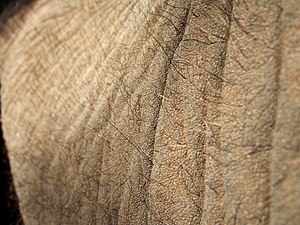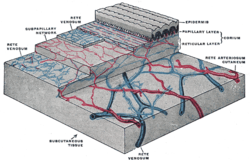Skin
| Skin | |
|---|---|

Skin of an elephant
|
|
| Details | |
| Identifiers | |
| Latin | Cutis |
| TA | A16.0.00.002 |
| FMA | 7163 |
|
Anatomical terminology
[]
|
|
| Dermis | |
|---|---|

The distribution of the bloodvessels in the skin of the sole of the foot. (Corium – TA alternate term for dermis – is labeled at upper right.)
|
|

A diagrammatic sectional view of the skin (click on image to magnify). (Dermis labeled at center right.)
|
|
| Identifiers | |
| MeSH | A17.815.180 |
| TA | A16.0.00.002 |
| FMA | 7163 |
|
Anatomical terminology
[]
|
|
Skin is the soft outer covering of vertebrates. Other animal coverings, such as the arthropod exoskeleton have different developmental origin, structure and chemical composition. The adjective cutaneous means "of the skin" (from Latin cutis, skin). In mammals, the skin is an organ of the integumentary system made up of multiple layers of ectodermal tissue, and guards the underlying muscles, bones, ligaments and internal organs. Skin of a different nature exists in amphibians, reptiles, and birds. All mammals have some hair on their skin, even marine mammals like whales, dolphins, and porpoises which appear to be hairless. The skin interfaces with the environment and is the first line of defense from external factors. For example, the skin plays a key role in protecting the body against pathogens and excessive water loss. Its other functions are insulation, temperature regulation, sensation, and the production of vitamin D folates. Severely damaged skin may heal by forming scar tissue. This is sometimes discoloured and depigmented. The thickness of skin also varies from location to location on an organism. In humans for example, the skin located under the eyes and around the eyelids is the thinnest skin in the body at 0.5 mm thick, and is one of the first areas to show signs of aging such as "crows feet" and wrinkles. The skin on the palms and the soles of the feet is 4 mm thick and the back is 14 mm thick and is the thickest skin in the body. The speed and quality of wound healing in skin is promoted by the reception of estrogen.
...
Wikipedia
